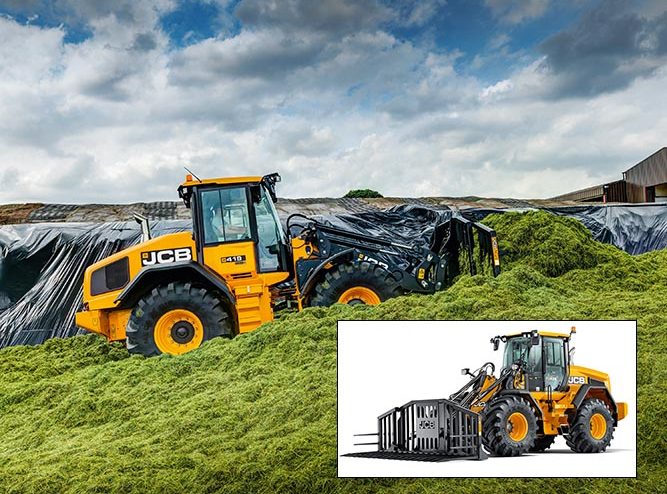
JCB’s two market-leading agricultural wheeled loaders – the 419S and 435S – have yet more performance and productivity to offer large farms and contract silage-harvesting operators thanks to significant increases in power and torque from their new engines.
The loaders continue to use a six-speed powershift transmission with extra-low first gear for exceptional pushing performance and torque lock-up in every gear for mechanically-efficient direct drive to the two heavy-duty axles.
But alongside an emissions control upgrade for European Stage V compliance, the 6.7-litre Cummins engine delivers up to 6.5% more power and up to 25.5% more torque.
John Smith, Managing Director, JCB Agriculture said: “Our ‘S’ series loaders, which are built and equipped specifically for agricultural applications, have always been at the top of their game and as the output of self-propelled forage harvesters continues to increase, we’ve responded with these new machines so that big farm and contracting operators can keep pace.”
In addition to the SCR diesel engine fluid system for controlling nitrogen oxides, the new engines have a diesel particulate filter (DPF), which is linked to JCB LiveLink telematics so that its status and any regeneration or servicing requirements can be remotely monitored alongside fuel use, operating hours and many other items of valuable fleet management information.
The engines also have a new electronic management system that provides a choice of two power and torque curves – one for site-to-site road travel and relatively light handling and loading operations, and one that exploits the full performance capabilities of the machines.
The default ‘standard’ power setting for the JCB 419S generates up to 107kW (144hp) at 2050rpm and 660Nm of peak torque.
But when full power is needed for maximum productivity to push-up large quantities of chopped grass or maize, the operator selects Dynamic mode to release up to 145kW (195hp) of peak power – up 6.5% from the Stage IV / Tier 4 Interim engine and supported by an increase of 5% in torque output to 881Nm.
The same system on the JCB 435S provides 171kW (230hp) at 2100rpm and up to 840Nm of torque for routine work – but when the forage is coming in thick and fast, Dynamic mode shifts the power curve upwards to peak at 188kW (252hp), up 9.5% up on the current model, with 25.5% more torque at a thumping 1186Nm.
Switching between the two power/torque ratings can be done with the loader stationary or on the move using the ‘DYN’ button located along with other function buttons in a cluster on the ‘B’ pillar of the spacious Command Plus cab.
The lower of the two power curves is the default setting when starting up first-thing but when Dynamic mode has been selected, this is memorised for two hours after the engine is switched off during breaks so that the machine remains primed and ready to go when work resumes.
In addition to the potential fuel-savings offered by the lower power/torque setting, fuel economy and engine servicing costs can benefit from the new Auto-Stop feature, which switches off the engine if it is left idling unnecessarily.
The operator can adjust the idling time limit using the menu dial for the functions display screen, which is mounted on the cab pillar and provides access to auxiliary hydraulic flow adjustment and other settings, including a new work light configuration.
Operators can now choose which rear work lights – on the roof or engine cover or both – come on when reverse is selected, and whether to have the front-mounted work lights illuminate when the road lights are switched from low to high beam for maximum forwards visibility on the road at night.
Another helpful aid is the forward-facing roof-mounted camera designed to supplement the operator’s view ahead when using a large attachment on the loader arms, such as a high volume high-tip bucket that can restrict the view forward.
Further refinement for the operator comes with the installation of rubber cushioning pads on the front face of the rear chassis to eliminate the ‘knock’ when steering to full lock, and the engine air filter is easier to reach in its new position immediately behind the cab, where it is also further way from swirling dust and dirt.